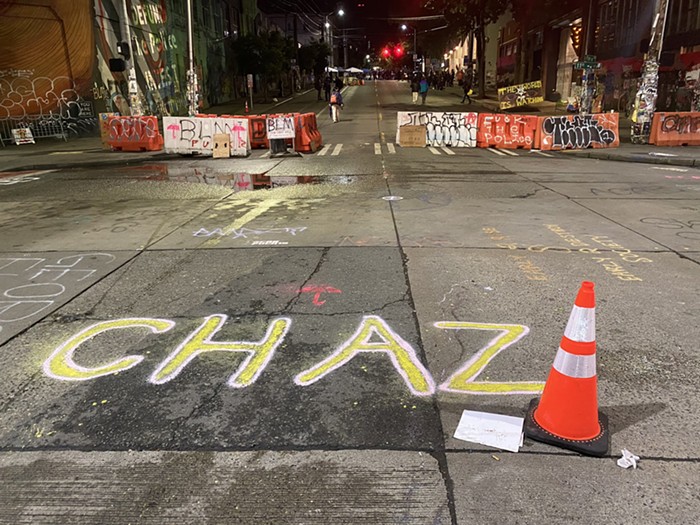
There are only two known futures for autonomous zones: One is institutionalization, the other is destruction.
The El Centro de la Raza on Beacon Hill is an excellent example of the former. The organization was established after students occupied an empty school building in 1972. A three-month standoff between activists in the building (the zone of autonomy) and the city ended with the city relenting and effectively transferring ownership of the building to the activists.
The paradigmatic autonomous space that ended badly (or, better say, very badly) is the Paris Commune, which was established by working-class Parisians after the collapse of the first great gentrification project in urban history, the Second Empire (1852 to 1870). Like Seattle's Africatown autonomous zone of 2013, the Paris Commune punctuated the vast, decades-long reorganization of Paris that cost the poor their neighborhoods and networks. The poor were pushed to the periphery, and the rich claimed more and more of the center. Anyone living in Seattle over the past two decades will instantly recognize this process and the patterns it produces.
The Paris Commune, which was born 18 March, 1871, was violently crushed on 28 May, 1871. Yale historian John Merriman estimates between 17,000 and 35,000 were killed by the army, with thousands deported. Africatown's autonomous zone, which emerged in the Horace Mann building in the Central District, was crushed by the SPD's SWAT team, which used battering rams and the threat of snipers.
Now, what will become of CHAZ?
Most likely it will be institutionalized. Judging by a June 9 press release from the mayor's office—"City Takes Steps to Create Safe Place for Peaceful Demonstrations"—that process has already begun. This is how the city is responding to the sudden appearance of a troublesome autonomous space in the heart of one of the most gentrified neighborhoods in Seattle: replacing force with safety, hard control with soft control. This shift in approach is departmentally expressed by the replacement of the Seattle Police Department with these three city organizations: the Seattle Fire Department, the Seattle Department of Transportation, and the Parks Department.
Mayor Jenny Durkan's Office, emphasis mine:
The Seattle Fire Department’s (SFD) mission is to save lives and protect property. Recognizing that the Seattle Police Department (SPD) East Precinct is adjacent to residential and commercial buildings, SFD has and may continue to upstaff resources near the area to ensure crews are appropriately equipped to respond to fires and medical emergencies when it’s safe to do so...What is at work here is the preservation of the space in the terms of middle-class ideals of order and beauty. This means it's now not a matter of the institutionalization of CHAZ but how it will be institutionalized. Will it become a El Centro de la Raza, which now provides real low-income housing to 300 residents and a plaza for politically progressive events like the Block Party at the Station? Or will it become like Manhattan's High Line, a park that, for sure, did not have an autonomous space as its source (it had instead what I call an orphaned space) but had the same public spirit as a CHAZ.To help keep the area safe and clean, Seattle Department of Transportation (SDOT) is picking up debris and trash, has cleaned graffiti that displayed hate, racist, and vulgar language or concepts, and has arranged for garbage cans and portable toilets to be placed in the vicinity for use by demonstrators. Streets are closed from 10th to 13th on Pine and on 11th between Olive and Pike....
To keep Cal Anderson Park a safe and cleanly gathering area, the Parks Department (SPR) is helping with garbage and debris clean-up, weeding and tree trimming, repair of damaged garden beds, and removal of graffiti. The department has also worked to repair damaged fencing and bathrooms, and is providing support for boarding-up local businesses. An artist has been brought in to create a mural at the Park. Lights at Cal Anderson will stay on until 4 a.m. to keep the area well lit.
Because the public spirit of the High Line appeared in isolation, it was soon captured by the speculators of real estate value. Properties next to and near it shot way up, and a whole chunk of billionaire urban development, the Hudson Yards was connected to its northern end. What will lead CHAZ in this direction is a combination of Durkan's soft control and contentless urbanism.
Hey Capitol Hill: this is a good opportunity to create superblocks for the people! https://t.co/pRUky9nTdc
— The Urbanist #DefundThePolice (@UrbanistOrg) June 9, 2020
This superblock proposal, which is strongly supported by Councilmember Teresa Mosqueda, will, in the context of Capitol Hill's gentrification, result in another High Line. It's likely to increase the value of the new developments that surround Cal Anderson Park and sections of the Pike/Pine corridor.
So, what is to be done? CHAZ must make demands to the city that are gentrification-proof. One such demand would be to claim the East Precinct and transform it into a community center with an emphasis on the provision of much-needed services for those thrown on the streets by unchecked property value inflation. CHAZ must imagine projects, programs, and futures that directly oppose and avoid cultural capture by tentacular capital. This is not an easy thing to do. But if a group is committed to the lasting progressive transformation of the CHAZ, the key indication that they're moving in the right diction will be Durkan's reversion to hard control.
TOMORROW! This movement needs you to get involved and stay involved, in any way you can. Come to the Capitol Hill Autonomous Zone tomorrow at 3pm. The work is just getting started. ❤️ pic.twitter.com/XR2ewgD9ul
— Spek (@spekulation) June 10, 2020













